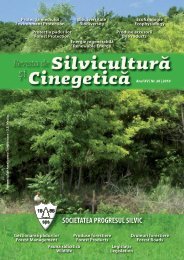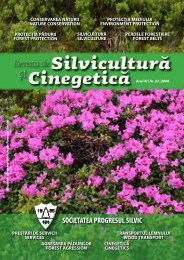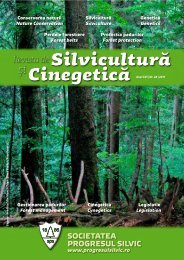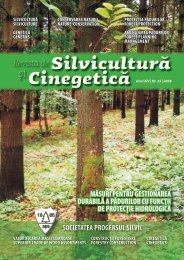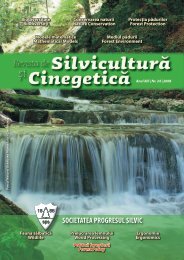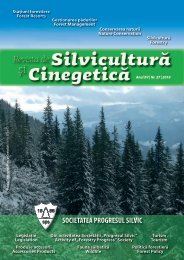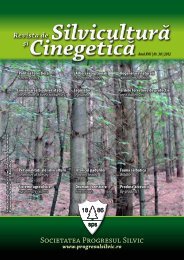Silviculture and Cinegetics Review - Societatea Progresul Silvic
Silviculture and Cinegetics Review - Societatea Progresul Silvic
Silviculture and Cinegetics Review - Societatea Progresul Silvic
Create successful ePaper yourself
Turn your PDF publications into a flip-book with our unique Google optimized e-Paper software.
FORESTRY BELTS SILVICULTURE AND CINEGETICS REVIEW XVII/30/2012<br />
system components, organization, socio-economic<br />
level <strong>and</strong> management) (Table 1).<br />
L<strong>and</strong> use is a classification criterion determined by<br />
use categories specific to our country <strong>and</strong> the type of<br />
management different in one category of use or the<br />
other. According to this criterion agroforestry systems<br />
are classified in: I) agroforestry systems in the forest<br />
fund, classified themselves in: i) intimately mixed<br />
cultures; ii) forestry corridors - source of animal feed<br />
mass; II) agroforestry systems in the agricultural<br />
fund, classified in: i) intercropping; ii) field protection<br />
forest belts, water course protection forest belts; iii)<br />
forest-pastoral systems (pastures with trees); iv)<br />
agroforestry-pastoral systems. This classification<br />
takes into account the different environmental<br />
conditions <strong>and</strong> priority production, forestry in the first<br />
case <strong>and</strong> agricultural in the second. The mentioned<br />
agroforestry systems are also the most common<br />
combinations of the three components. Some of<br />
them have been practiced in our country over<br />
time <strong>and</strong> continue to be practiced, although in a<br />
less organized manner, others, such as forestry<br />
corridors - source of animal feed mass <strong>and</strong><br />
intercropping in agroforestry sense, are news for<br />
our country.<br />
3. Characteristics of the main<br />
agroforestry systems<br />
3.1. Intimately mixed cultures<br />
Intimately mixed cultures are agroforestry systems,<br />
which consist of agricultural species growing among<br />
forest species rows of young plantations in order to<br />
achieve maintenance, diversification of production<br />
<strong>and</strong> improve soil properties (fig. 1). Therefore, in long<br />
term, the main objective of this agroforestry system is<br />
achieving timber production in less time <strong>and</strong> of better<br />
quality.<br />
Through the maintenance of crops forest cultures<br />
benefit from more maintenance than usual <strong>and</strong>, in<br />
some cases even additional water intake (when crops<br />
are irrigated). Also, by maintaining crops within the<br />
system <strong>and</strong> implicitly the forest cultures is resolved<br />
the issue of labor in forestry, difficult to procure for<br />
forestry work. Crop yields that are obtained in this<br />
agroforestry system can compensate labor costs, but<br />
also contributes to increasing rural incomes.<br />
Fig. 2. Eeuramerican poplar culture in intimate mixture with corn<br />
installed at D.S. Brăila (Mihăilă et al., 2010)<br />
Combination of agricultural species <strong>and</strong> the forest<br />
cultures is done from plantation installation until the<br />
latter reach their massive state. It is done in forest<br />
plantations installed in large planting schemes (from<br />
2.00 x 1.00 m to 7.00 x 7.00 m) to enable the<br />
mechanization of maintenance <strong>and</strong> / or harvesting of<br />
crops.<br />
64



